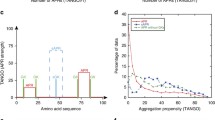Abstract
Escherichia coli is a widely-used cell factory for recombinant protein production, nevertheless, high amount of produced protein is seen in aggregated form. The purpose of this study was to improve the solubility of recombinant bovine sex-determining region Y protein (rbSRY) by exploring the effect of temperature, inducer, and water-arginine mixed solvent. Codon-optimized rbSRY expressed in Rosetta-gami B (DE3) pLysS and purified by NI–NTA His-select affinity chromatography in the native and denaturing conditions. A three-dimensional model of SRY was built and studied through molecular dynamics simulations in water and in the presence of l-arginine as co-solvent. Results indicated the significant effects of temperature and IPTG concentration (P < 0.001) on the solubility of rbSRY. The binding activity of native, inclusion bodies and refolded fractions to anti-rbSRY monoclonal antibody were concentration-dependent (P < 0.001). Based on molecular modeling results, the propensity of fragments in the N-terminal domain to form β-sheet and the relative instability of α-helices in terminal domains are the probable reasons for the high aggregation potential of SRY, which are mitigated in the presence of l-arginine. Altogether, our rbSRY protein was properly produced and applying appropriate culture conditions could help enhance its solubility, refold inclusion bodies, and improve its activity upon refolding.





Similar content being viewed by others
References
Rosano GL, Ceccarelli EA (2014) Recombinant protein expression in Escherichia coli: advances and challenges. Frontiers Microbiol. https://doi.org/10.3389/fmicb.2014.00172
Auslender EL, Dorion S, Dumont S, Rivoal J (2015) Expression, purification and characterization of Solanum tuberosum recombinant cytosolic pyruvate kinase. Protein Expr Purif 110:7–13
de Groot NS, Ventura S (2006) Effect of temperature on protein quality in bacterial inclusion bodies. FEBS Lett 580(27):6471–6476
Schultz T, Martinez L, De Marco A (2006) The evaluation of the factors that cause aggregation during recombinant expression in E. coli is simplified by the employment of an aggregation-sensitive reporter. Microbial Cell Factor 5(1):28
Soleymani B, Hafezian SH, Mianji GR, Mansouri K, Chaharaein B, Tajehmiri A et al (2017) Bovine sex determining region Y: cloning, optimized expression, and purification. Anim Biotechnol 28(1):44–52
Malik A, Alsenaidy AM, Elrobh M, Khan W, Alanazi MS, Bazzi MD (2016) Optimization of expression and purification of HSPA6 protein from Camelus dromedarius in E. coli. Saudi J Biol Sci. 23(3):410–419
Fox JM, Erill I (2010) Relative codon adaptation: a generic codon bias index for prediction of gene expression. DNA Res 17(3):185–196
Prasad S, Khadatare PB, Roy I (2011) Effect of chemical chaperones in improving the solubility of recombinant proteins in Escherichia coli. Appl Environ Microbiol 77(13):4603–4609
Ishibashi M, Sakashita K, Tokunaga H, Arakawa T, Tokunaga M (2003) Activation of halophilic nucleoside diphosphate kinase by a non-ionic osmolyte, trimethylamine N-oxide. J Protein Chem 22(4):345–351
Hirai A, Kawasaki H, Tanaka S, Nemoto N, Suzuki M, Maeda H (2006) Effects of L-arginine on aggregates of fatty-acid/potassium soap in the aqueous media. Colloid Polym Sci 284(5):520–528
Tsumoto K, Ejima D, Kita Y, Arakawa T (2005) Why is arginine effective in suppressing aggregation? Protein Pept Lett 12(7):613–619
Rudolph R, Fischer S, Mattes R (1985) Process for the activation of tPA after expression in prokaryotic cells. Patent DE3537708
Soleymani B, Mostafaie A (2019) Analysis of methods to improve the solubility of recombinant bovine sex determining region Y protein. Reports of Biochemistry and Molecular Biology, pp 227–235
Chiti F, Dobson CM (2009) Amyloid formation by globular proteins under native conditions. Nat Chem Biol 5(1):15–22
Li D, Ji F, Huang C, Jia L (2019) High expression achievement of active and robust anti-β2 microglobulin nanobodies via E coli hosts selection. Molecules 24(16):2860
Baneyx F, Mujacic M (2004) Recombinant protein folding and misfolding in Escherichia coli. Nat Biotechnol 22(11):1399–1408
Schein CH (1989) Production of soluble recombinant proteins in bacteria. Nat Biotechnol 7(11):1141–1149
Lim K-P, Li H, Nathan S (2004) Expression and purification of a recombinant scFv towards the exotoxin of the pathogen, Burkholderia pseudomallei. J Microbiol 42(2):126–132
Kiefhaber T, Rudolph R, Kohler H-H, Buchner J (1991) Protein aggregation in vitro and in vivo: a quantitative model of the kinetic competition between folding and aggregation. Nat Biotechnol 9(9):825–829
Xie L, Hall D, Eiteman M, Altman E (2003) Optimization of recombinant aminolevulinate synthase production in Escherichia coli using factorial design. Appl Microbiol Biotechnol 63(3):267–273
Rodríguez-Carmona E, Cano-Garrido O, Dragosits M, Maurer M, Mader A, Kunert R et al (2012) Recombinant Fab expression and secretion in Escherichia coli continuous culture at medium cell densities: influence of temperature. Process Biochem 47(3):446–452
Chiti F, Stefani M, Taddei N, Ramponi G, Dobson CM (2003) Rationalization of the effects of mutations on peptide and protein aggregation rates. Nature 424(6950):805–808
Nayeem SM, Deep S (2010) Rationalization of poor solubility of TGF-beta3 using MD simulation. Biochem Biophys Res Commun 401(4):544–547
Tsumoto K, Abe R, Ejima D, Arakawa T (2010) Non-denaturing solubilization of inclusion bodies. Curr Pharm Biotechnol 11(3):309–312
Wu B, Nemeth JF, Janecki DJ, Jones B, Obmolova G, Malia TJ et al (2011) Expression, refolding and purification of a human interleukin-17A variant. Cytokine 53(1):107–114
Baynes BM, Wang DI, Trout BL (2005) Role of arginine in the stabilization of proteins against aggregation. Biochemistry 44(12):4919–4925
Canchi DR, García AE (2013) Cosolvent effects on protein stability. Annu Rev Phys Chem 64:273–293
Author information
Authors and Affiliations
Corresponding author
Additional information
Publisher's Note
Springer Nature remains neutral with regard to jurisdictional claims in published maps and institutional affiliations.
Electronic supplementary material
Below is the link to the electronic supplementary material.
Rights and permissions
About this article
Cite this article
Soleymani, B., Barzegari, E., Mansouri, K. et al. Heterologous expression, purification, and refolding of SRY protein: role of l-arginine as analyzed by simulation and practical study. Mol Biol Rep 47, 5943–5951 (2020). https://doi.org/10.1007/s11033-020-05667-1
Received:
Accepted:
Published:
Issue Date:
DOI: https://doi.org/10.1007/s11033-020-05667-1




